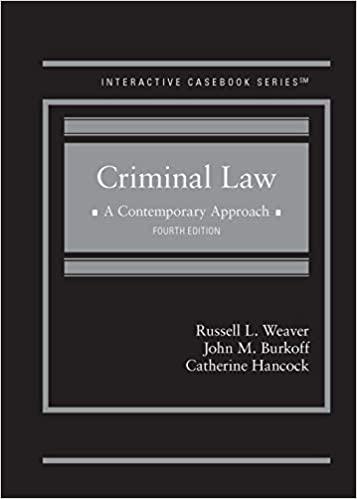Question
Case 13.2 Wilson Sporting Goods v Hickox District of Columbia Court of Appeal 59A3d 1267(2013) At the annual retreat for Major League Baseball umpires a
Case 13.2 Wilson Sporting Goods v Hickox
District of Columbia Court of Appeal 59A3d 1267(2013)
At the annual retreat for Major League Baseball umpires a Wilson (sporting Good Company)representative gave(Edwin)Hickox an umpries mask with what the representative claimed was a new,safe design. Several months later, MR .Hickox wore the mask while working behind home plate as an umpire during a game in Washington DC .In the top of the ninth inning a foulf tipped ball struck the mask.The impact of the ball gave Mr Hickox a concussion. It damaged a joint between the bones in Mr Hickox inner eatAs a result, Mr Hickox suffered the permanent hearing loss of mild to moderate severity. The mask was traditional umpires"s mask, but it had a newly designed throat guard that angled forward instead of extending straight down. According to The Hickoxes the throat guard should have had a center wired and should have extended straight down with no forward angle.Because the mask lacked these features, when the ball hiy the throat guard,the mask did not deflect the ball but instead temporarily trapped the ball, concentrating the energy of the ball at the point of impact. As a result, the mask was driven into Mr Hickox jaw with great force.
In contrast to the Hickoxes version , Wilson contended the following trail. The ball hit the mask above the throat guard,not on it , so the same injury would have occurred even if the mask had not had a throat guard. Wilson intended the mask to provide protection by deflecting balls away from the wearer's head and the mask accomplished this objective during the accident.
Hickox and his wife filed a suit in a Doistcit of the Columbia court against Wilson, claiming product liability based on a design defect.The jury rendered verdict for the Hickoexes awarding $750,000 to Mr Hickox and $25,000 to his wife.(Wilson appleade argued that the evidence was insufficient to support the verdict)
There are two tests commonly used to determine whether a product design is defective the consumer-expectation test and the risk utility test.
Wilson explicitly assented at trial to jury instructions that required the jury to make findings under a consumer-expectation test .Specifically, the jury was told that a design is defective if the product fails to perform as safely as an ordinary customer would expect when the product is used in an intended or reasonable manner.
Accordingly we employe the consumer-expectation test to evaluate the sufficiency of the evidence in this case.
The evidence indicated that the mask at issue was more dangerous than the comparable mask sold at the time, such a hokey style mask because the mask could concentrate than distribute energy level evenly throughout the padded area of the mask.Because the energy possessed by a pitched baseball is adequate to cause severe injuries, the jury could reasonably have concluded that a mask that concentrated energy would increase the risk of severe injury.
The jury could also have relied on the existence of safer , commercially available alternatives to draw inferences about the level of safety an ordinary user would expect. There was evidence that alternatives masks with detachable throat guards and no forward angle work well and are not excessively restrict the umpires moment.There also was evidence that Mr. Hickox would not have suffered an injury to his ear had he been wearing a hockey-style mask or a mask with center wire and no forward angle.
testifiedIn adddiotn the jury could have concluded that the statement made by Wilsons representative to MrWilson's Hickox about the mask reflected . standard marketing approach and that an ordinary consumer, therefore Wilson's, would have expect the mask to perform more safely than other models. There was Hickox also that he believed that companies that Wilson evidence told Mr Hickox that the mask would disperse energy and protect against concussion and that the mask was the best and safest technology.Mr Hickox also testified that he believed that companies like Wilson tested new products and did not sell them unless they were safe to use.Jurors could consider such testimony in combination with. their own reasonable inferences to determine ordinary consumer expectations.
Wilsons objective in designing the mask was to despere energy, not concatenate it.At the time of the accident, Wilson tested its hockey-style mask to determine if they met the impact intensity standards but did not perform such a test on it baseball mask.At the time when Wilson used energy dispersal as a design objective fo its baseball mask and when impact-intensity standards existed for football helmets, a reasonable juror could infer that an ordinary consumer would have expected baseball masks to disperse rather than concentrate energy .
In sum considering all the evidence, a reasonable juror could conclude that an ordinary consumer would have expected the mask to perform more safely than it did.(emphasis added)
The judgment of the trial court is, therefore.
Affirmed.
please answer what your opinion is
WHAT IF THE FACTS WERE DIFFERENT?
Suppose that the parties had carefully read the contract before they signed it. If they had been sure that the agreement stated what they intended and if everything discussed was I. writing, how might the outcome of this case have been different?
Step by Step Solution
There are 3 Steps involved in it
Step: 1

Get Instant Access to Expert-Tailored Solutions
See step-by-step solutions with expert insights and AI powered tools for academic success
Step: 2

Step: 3

Ace Your Homework with AI
Get the answers you need in no time with our AI-driven, step-by-step assistance
Get Started


